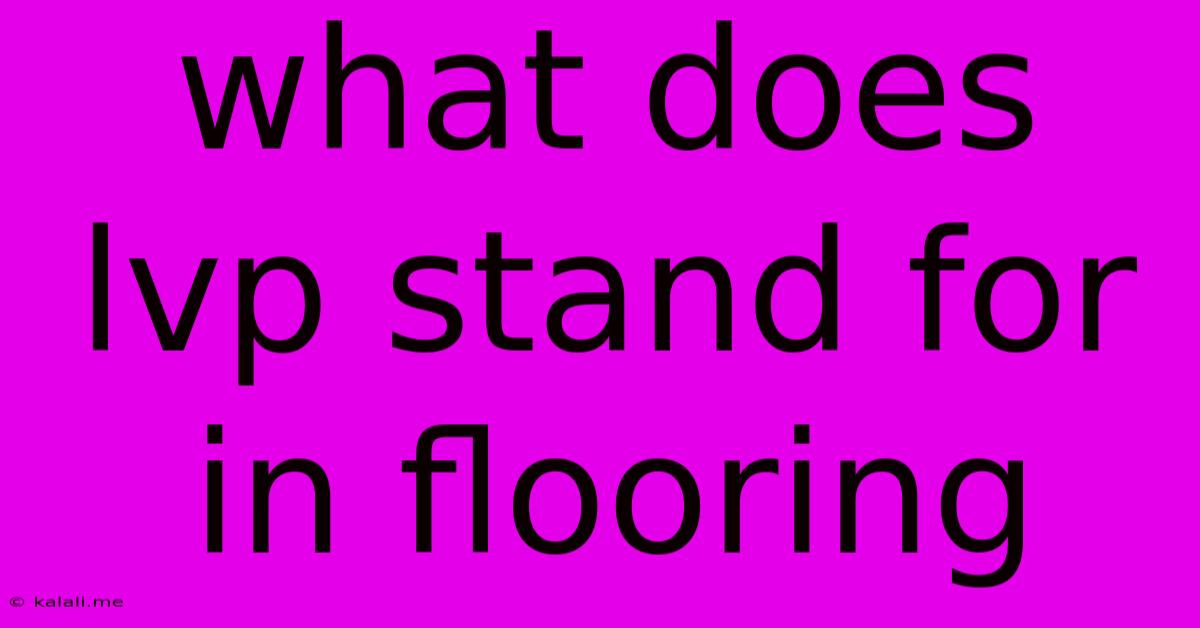What Does Lvp Stand For In Flooring
Kalali
May 27, 2025 · 4 min read

Table of Contents
What Does LVP Stand For in Flooring? A Comprehensive Guide
Meta Description: Confused about LVP flooring? This comprehensive guide explains what LVP stands for (Luxury Vinyl Plank), its benefits, drawbacks, and how it compares to other flooring options. Learn everything you need to know before choosing LVP for your home.
Luxury vinyl flooring is a popular choice for homeowners, offering a blend of style, durability, and affordability. But what exactly does LVP stand for? It stands for Luxury Vinyl Plank, a type of flooring that mimics the look of hardwood, stone, or tile, but with the added benefits of being water-resistant, durable, and relatively easy to maintain. This article will delve into the details of LVP flooring, exploring its features, advantages, disadvantages, and helping you determine if it's the right choice for your home.
Understanding Luxury Vinyl Plank (LVP)
LVP flooring consists of multiple layers designed to create a realistic and resilient product. These layers typically include:
- Wear Layer: The topmost layer, responsible for protecting the flooring from scratches, scuffs, and stains. The thickness of this layer dictates the durability of the LVP. Thicker wear layers generally indicate a more resilient floor.
- Printed Layer: This layer features the high-resolution image that replicates the look of natural materials like hardwood, stone, or tile. Advanced printing techniques allow for incredibly realistic textures and patterns.
- Core Layer: The core is the structural layer of the LVP, providing stability and strength. Different core types (such as rigid core, composite core, and WPC) influence the overall performance and characteristics of the flooring.
- Backing Layer: The bottom layer provides cushioning and stability, further enhancing comfort underfoot and reducing sound transmission.
Advantages of LVP Flooring
LVP has gained immense popularity due to its numerous advantages:
- Water Resistance: A significant advantage of LVP is its superior water resistance, making it ideal for kitchens, bathrooms, and basements – areas prone to moisture. This is a significant upgrade over traditional hardwood flooring.
- Durability: LVP is highly durable and can withstand heavy foot traffic, making it a practical choice for homes with children or pets. Its resistance to scratches and dents makes it a long-lasting investment.
- Affordability: Compared to hardwood or natural stone, LVP is generally more affordable, making it an accessible option for various budgets.
- Easy Installation: Many LVP planks feature a click-lock system, allowing for relatively easy DIY installation. This reduces labor costs compared to other flooring types.
- Wide Variety of Styles: LVP offers a vast range of styles, colors, and textures, mimicking the appearance of various natural materials. This allows for customization to match any home decor.
- Easy Maintenance: Cleaning LVP flooring is simple and requires minimal effort. Regular sweeping or vacuuming, along with occasional mopping, keeps it looking its best.
Disadvantages of LVP Flooring
While LVP offers many benefits, it's important to consider its drawbacks:
- Potential for Expansion and Contraction: While improvements in core technology have lessened this, LVP can still expand and contract slightly with changes in temperature and humidity. Proper acclimation before installation is crucial.
- Less Comfortable Underfoot (some types): Depending on the core type, some LVP can feel less comfortable underfoot than other flooring options, especially without underlayment.
- Can Feel Less Luxurious (than high-end alternatives): Although named "luxury" vinyl plank, it may not feel as luxurious underfoot as high-end hardwood or natural stone.
LVP vs. Other Flooring Options
LVP often competes with other flooring types:
- Hardwood: While hardwood offers a classic look and feel, it's more expensive, less water-resistant, and requires more maintenance.
- Laminate: Laminate is also affordable and durable, but it lacks the water resistance of LVP and doesn't offer the same realistic look.
- Tile: Tile is durable and water-resistant, but it can be cold and hard underfoot, and installation can be more complex and expensive.
Choosing the Right LVP Flooring
When selecting LVP, consider factors such as:
- Wear layer thickness: A thicker wear layer offers greater durability.
- Core type: Different core types provide varying levels of stability, water resistance, and comfort.
- Style and color: Choose a style that complements your home's décor.
- Warranty: A good warranty provides peace of mind.
In conclusion, LVP, or Luxury Vinyl Plank, represents a compelling flooring option for many homeowners. Its blend of affordability, durability, and water resistance makes it a strong contender in the flooring market. By understanding its advantages and disadvantages, you can make an informed decision about whether LVP is the right choice for your home improvement project.
Latest Posts
Latest Posts
-
Toilets Won T Flush After Heavy Rain
May 28, 2025
-
Google Sheets Count Lines In Cell
May 28, 2025
-
David Changed His Behavior Before Abimelech
May 28, 2025
-
Ac High Pressure On Low Side
May 28, 2025
-
How To Keep Fruit Flies Away From Fruit Bowl
May 28, 2025
Related Post
Thank you for visiting our website which covers about What Does Lvp Stand For In Flooring . We hope the information provided has been useful to you. Feel free to contact us if you have any questions or need further assistance. See you next time and don't miss to bookmark.